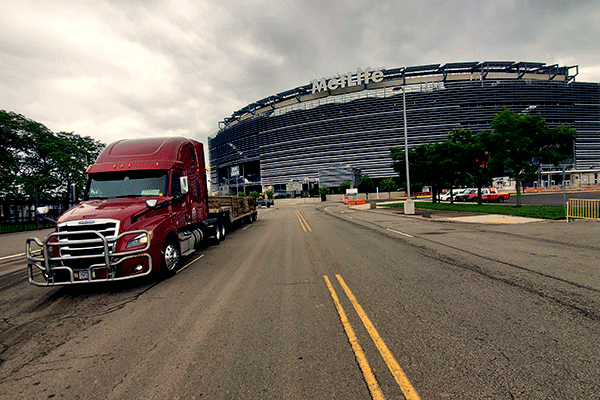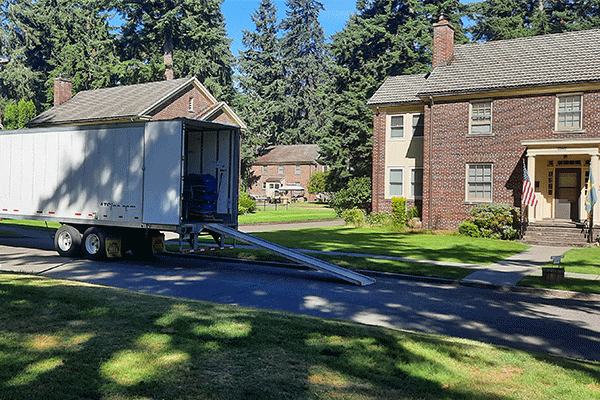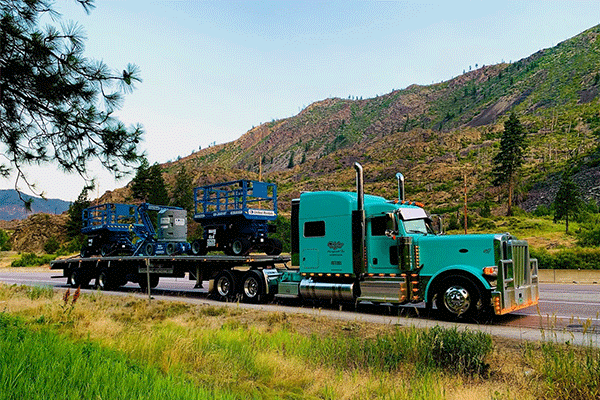Not to be the bearer of bad news but you may be overpaying for your freight. Sure, spending an extra dollar here or there isn’t terribly destructive. You’ve been known to swing an occasional splurge purchase. To substitute your homemade brew for some store-bought java or to pump unleaded 89 rather than 87.
When it comes to your shipping budget, though, these things tend to add up. And, before long, you’re likely to see their impact on your bottom line.
All of this isn’t to say that you’re to blame. How could you have known that a step-deck trailer would work just as well as a flatbed for your freight? Or, that using a dry van for your palletized goods may be better than an open-deck trailer.
Had you known these things, you likely could’ve saved some money on your freight costs. But alas, you simply didn’t.
Here at ATS, we’ve been working within the trucking industry since 1955. During this time, we’ve been an active participant in the transportation world’s growth. As such, we understand the nooks and crannies of this industry including how you can save a bit of money by thinking outside the box.
Today, let’s talk about four ways you can give your shipping budget a bump by adding a bit of creativity to your processes.
Four ways to save money on your freight rates are:
- Add flexibility to your trailer type requirements
- Hold more frequent RFQs
- Incorporate driver-friendly practices
- Develop longstanding relationships with providers
⏬ Listen to the podcast on this topic ⏬
View other listening options >
#1 Add Flexibility to Your Trailer Type Requirements
In the transportation business, supply and demand dictate the final price of getting freight moved. As the supply of available trucking solutions diminishes, while the demand for services holds steady, costs rise.
And, in a tight market, where the supply of trailer space is consistently lower than the demand for their services, securing affordable rates can be difficult for companies with products to move.
So what can they do? How can good companies, with customers waiting and money on the line, tilt the scales — however minutely — back in their favor?
The answer, which isn’t plain to see, seems simple enough; when the amount of trailer space you have to choose from matters, increase your supply. It’s actually quite actionable.
If you want more friendships, open yourself up to other opportunities to make connections. If you want more supper-time meal options, work to expand your palate away from the usual things like pizza and chicken patties.
If you want to save money on your freight rates, you’ll need to increase your pool of options — take back some bargaining power.
Too often, shippers find themselves stuck in a rut. They utilize a tried and true method for moving their freight and develop a reliance on a single equipment type.
But, over time, their preferred method of transportation becomes more pricey. And, thinking there’s no other option, these shippers pay the going rate, losing out on some easily reachable cost savings.
Just like the capuchin monkey, who doesn’t always settle for the lowest hanging apple but instead climbs higher where the larger, sweetest, fruit resides, let’s reach beyond the obvious choice going forward.
How Should You Approach Trailer Type Flexibility?
Before you can open yourself to an increased pool of trailer options, you’ll need to understand what’s reasonable. For the most part, this nation’s products have a very specific set of constraints dictating the type of trailer needed to haul them.
That said, in certain scenarios, finding a unique option for a shipment is more than possible.
For example:
Sometimes, palletized open-deck freight requires protection from the elements in transit. For many shippers, there are two obvious options for moving these commodities:
1. Utilize an open-deck trailer and cover with tarps
Tarping open-deck freight is the most common method for moving products that require protection during transit. Although tarping comes at a cost, it’s relatively affordable and presents a competent solution for these items.
2. Utilize a Conestoga trailer
Conestogas are another natural remedy for protecting freight from weather damage during transport. Their full-length curtain system allows open deck freight — provided it isn’t over-dimensional (OD) — to be fully protected in transit.
Sure, each of these modes of transport can get the job done. And, for many shipments, tarping freight or using a Conestoga will provide the perfect solution. But let’s think a bit harder.
In this scenario, there’s actually a third, more creative option. Since the cargo in question is completely palletized — which allows it to be loaded from the back or sides — moving this freight inside of a dry van trailer is also on the table.
Think about it. For a shipment that is palletized, needs 53 feet of trailer space and requires protection from the elements, a dry van checks all of the boxes.
As such, the shipper of these goods may be able to save a substantial amount of money by opening themselves up to, and searching for, dry van capacities.
Whether it’s a 43-foot load that could be hauled on either a flatbed or a step-deck, or a smaller load of equipment warranting both hotshot and straight truck transportation, the options are out there. A competent provider, with a demonstrated history of success, will help you find them.
#2 Hold More Frequent RFQs
A request for quote (RFQ) is a staple way that companies around the world select their transportation providers. Commonly hosted annually and semi-annually, an RFQ allows both shippers — and their motor carriers — the opportunity to refresh their pricing, reiterate expectations and plan for the future.
While RFQs are a great way to secure standing capacity and spark the flame of a long-term partnership, over time the cost of transportation services — agreed-to months before — can become outdated.
You see, pricing in the trucking industry is constantly in flux. From each day to the next, absolute pricing is difficult to predict as supply and demand — which are influenced by many factors — change their tune.
As a result, the worn-out price points of a prior RFQ may be damaging to your bottom line. Whether your current pricing is higher than it needs to be to secure capacity, or too low to find a trucker willing to haul your load, refreshing your contracts more frequently than once or twice a year can be valuable.
Beyond this, holding more frequent RFQs helps your transportation provider plan for the future.
Your provider’s ability to meet your needs relies heavily on maintaining an intimate knowledge of your volume requirements and timelines. Holding an RFQ more often is a prime way for them to refresh these understandings. In turn, this influx of communication over exactly what you need going forward, helps them refine the efficiency of your pricing — saving you money.
This can be especially beneficial for businesses that find their needs fluctuating seasonally. As your transportation requirements change — whether on a single lane or a larger scale — consider holding another RFQ to meet them.
As transportation companies work to schedule out trucks for your shipments, receiving accurate pricing for your loads helps exponentially. Even if it’s as simple as holding a bid on a smaller scale — for an individual lane, perhaps — securing up-to-date quotes for your freight can be beneficial.
That said, make sure to verify your current contracts against current market conditions before hosting an RFQ. When in doubt, a competent provider will help you make these decisions for your supply chain.

#3 Incorporate Driver-Friendly Practices into your Operations
Truckers are the driving force of your transportation supply chain. Nothing gets moved without their assistance, making the part they play central to your success. As such, your shipping budget is intimately tied to a driver’s willingness to serve your load.
In recognition of this, here are four things you can do today to save money — with driver-friendly practices — in the future:
1. Provide clear directions for drivers to follow
Truckers like freight that makes the procedures at pick up and drop locations clear. This includes information like what a driver should do upon arrival, where they should park and what side of the building they should enter on.
2. Offer overnight parking
Truck drivers are only allowed to be actively on-duty for 14 straight hours during a 24-hour period. Following their stretch of on-duty time, truckers must take a 10-hour break. Giving truckers a location to park, sleep and refresh while their clock resets will make your freight all the more desirable.
If a carrier can plan out their schedule with your overnight parking as a resting point — before they pick up or after they unload your shipment — expect to pay a bit less for a willing driver.
3. Efficient Loading Times
For a driver to make the most of their hours of service (HOS), the amount of time you spend loading their trailer must be efficient. Too often, truckers are left with limited on-duty hours remaining after a prolonged loading/offloading process. Since hauling freight is the only way they make money, truckers like to avoid situations where loading times are an issue.
To save money on your freight costs, work to expedite your loading procedures. Bringing on additional help in your shipping department, if feasible, is a great way to avoid detention and layover charges. Although the up-front cost of adding an employee may seem steep, you’ll save exponentially more money long-term.
4. Help with tarping and blocking
Some freight requires specialized services such as tarping on open-deck commodities and blocking for dry van products. These can be time-consuming practices and often make a load with these requirements less appealing to drivers.
As such, the more you can do to help a driver do these — and expedite this process — the better off you’ll be. Some shippers even have a system of pulleys on sight to help drivers throw tarps onto freight.

#4 Develop Long-Standing Relationships With Your Providers
Relationships make the business world go around. Moving your freight is just as much a business as any other and success is a two-way street. It’s far easier to meet your goals and maintain your bottom line with strong partnerships by your side.
To save money on your shipping costs, make your transportation partnerships a priority. As you and your provider get to know one another’s competencies, goals and procedures, efficiencies will follow.
Strive to develop a relationship with your partner that is more than simply transactional. As obvious as it may seem, many shippers fail to do this and their supply chains suffer because of it.
Maintain your partnerships, utilize core carriers and hone your efficiencies together, you’ll save money in the process.
Select a Great Transportation Provider
Having an expert partner on your side will help you make the most of your budget far beyond doing any one of these activities. Allowing flexibility in your equipment will expand your career options and save you money. The right partner will show you how.
That said, finding great companies to work with throughout this industry can be difficult. Use the tools below to help you find, vet and select the right transportation provider for your needs:
- Freight Brokerage Selection Common Mistakes Guide
- Freight Brokerage Selection Checklist
- 6 Key Factors for Choosing the Right Carrier
Here at ATS, we take pride in helping shippers, like you, get the most from their transportation dollars. We understand that this industry can be intimidating, there’s just so much going on. As such, we make it our goal to point shippers toward the information they’re looking for, whenever they need it.
To do this, we publish educational content to our Learning Hub multiple times every week. Check it out, and if there’s something you’re looking for that isn’t there, please let us know. We’d love to answer any questions you may have.


